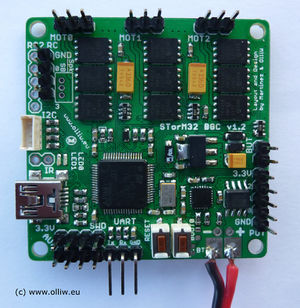STorM32 Boards: Difference between revisions
Jump to navigation
Jump to search
No edit summary |
No edit summary |
||
| Line 1: | Line 1: | ||
At present, | At present, v1.1, v1.2, and v1.3 STorM32-BGC boards are in use (v0.17/v1.0 boards are deprecated). | ||
'''''Comments:''''' | '''''Comments:''''' | ||
| Line 6: | Line 6: | ||
* ''For a detailed description of the various connectors on the board see [[Pins and Connectors]].'' | * ''For a detailed description of the various connectors on the board see [[Pins and Connectors]].'' | ||
* ''To avoid confusion/misunderstandings please note: The boards provide many features hardware-wise, but not all are yet supported by the firmware. Please check the firmware description to find out (see e.g. the [http://www.olliw.eu/2013/storm32bgc/#firmware project page]).'' | * ''To avoid confusion/misunderstandings please note: The boards provide many features hardware-wise, but not all are yet supported by the firmware. Please check the firmware description to find out (see e.g. the [http://www.olliw.eu/2013/storm32bgc/#firmware project page]).'' | ||
{{COMMENT|There exist also other boards, but their schemes have not been published (although required by the license) and are hence not discussed here.}} | |||
== STorM32-BGC v1.3 == | == STorM32-BGC v1.3 == | ||
| Line 26: | Line 28: | ||
| | | | ||
* supply voltage: 6 - 18 V or 2 - 4S | * supply voltage: 6 - 18 V or 2 - 4S | ||
* motor current: max. 1.5 A per motor<br/>'''''Comment''': This is not yet fully exploited and also depends on the package, with DFN packages motors with resistances of 12 Ohm or larger have been tested to be well handled at 4S (see [//www.rcgroups.com/forums/showthread.php?t=2055844&page=2&pp=50#post27515444 here], [//www.rcgroups.com/forums/showthread.php?t=2055844&page=15&pp=50#post28578479 here]), | * motor current: max. 1.5 A per motor<br/>'''''Comment''': This is not yet fully exploited and also depends on the package, with DFN packages motors with resistances of 12 Ohm or larger have been tested to be well handled at 4S, motors with 10 Ohm may be handled with care; for the latest summary see [http://www.rcgroups.com/forums/showpost.php?p=30564101&postcount=3166 here] (for details see also [//www.rcgroups.com/forums/showthread.php?t=2055844&page=2&pp=50#post27515444 here], [//www.rcgroups.com/forums/showthread.php?t=2055844&page=15&pp=50#post28578479 here]), [http://www.rcgroups.com/forums/showpost.php?p=28825482&postcount=947 here] and [http://www.rcgroups.com/forums/showpost.php?p=28852888&postcount=953 here])''. | ||
* board dimensions: 50 mm x 50 mm, 45 mm bolt to bolt, holes Ø3 mm | * board dimensions: 50 mm x 50 mm, 45 mm bolt to bolt, holes Ø3 mm | ||
|} | |} | ||
Revision as of 04:11, 23 January 2015
At present, v1.1, v1.2, and v1.3 STorM32-BGC boards are in use (v0.17/v1.0 boards are deprecated).
Comments:
- The boards can be populated with different motor drivers: the TC4452 driver in DFN package or the TC4452 driver in SOIC package; the DFN package allows somewhat higher motor currents.
- The boards can in principle be populated with different microcontrollers; the standard configuration is a STM32F103RC.
- For a detailed description of the various connectors on the board see Pins and Connectors.
- To avoid confusion/misunderstandings please note: The boards provide many features hardware-wise, but not all are yet supported by the firmware. Please check the firmware description to find out (see e.g. the project page).
Comment: There exist also other boards, but their schemes have not been published (although required by the license) and are hence not discussed here.
STorM32-BGC v1.3
|
|
STorM32-BGC v1.2
Differences to the v1.3 board:
- voltage regulator: smaller SOT223 package
- only 2 auxiliary ports
STorM32-BGC v1.1
Differences to the v1.2 board:
- no Futaba S-bus support
- Spektrum satellite is supported, but no extra Spektrum connector on board
- no extra USB voltage protection diode
- voltage regulator: smaller SOT223 package
- only 2 auxiliary ports
Comment: The order of pins on the I2C#2 port is reversed to that on the I2C#1 port; please consider this then connecting an MPU module to the I2C#2 port. Note that this does not apply to the witespy board; here the issue has been resolved by a smart plug.


